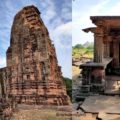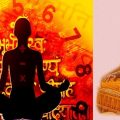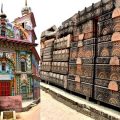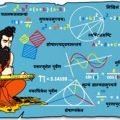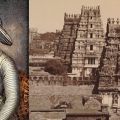Temple Treasures: Evolution of Temples from Ancient to Present

Amit Agarwal’s new book Temple Treasures: A Journey Through Time, published by Subbu Publications, is a collection of stories and theories about the evolution, construction, and other facets of Hindu and Buddhist temples. His earlier books Swift Horses Sharp Swords and A Never-Ending Conflict were well received in the market and delineated entirely new thoughts on history.
Temple Treasures: A Journey Through Time is an evocative and meticulously researched exploration of India’s rich heritage, crafted by Amit Agarwal, an author deeply passionate about the nation’s glorious past. This book serves as a testament to the resilience and brilliance of Indian civilization, presenting a compelling narrative that weaves together history, culture, and the indomitable spirit of India’s ancestors.
The book starts by delineating the evolution of temples since the beginning. According to the book, they evolved from the agnikunds of the Vedic era, and by 500 CE, we were creating sky-high temples that, in beauty, surpassed even the Egyptian ones. The book also delves into the evolution of Buddhist monasteries and how Hindu kings sponsored them.
One of the book’s standout features is its focus on temples as centers of excellence. The first half of the Temple Treasures: A Journey Through Time focuses on what a temple is, its concept, Vastu Shastra, mandala, types of temples, and temples according to scriptures. It then goes on to explain the geographical settings, architecture, sculptures, and paintings of the temple. It also delves into the ancient manuscripts and inscriptions found in the temples to buttress the fact of glorious ancient civilisation. The author then goes beyond the architectural splendour of these ancient structures, delving into their role as hubs of education, economic activity, and cultural preservation. By doing so, the book highlights how temples were more than just places of worship; they were vital to the socio-economic fabric of ancient India.
The second half of the book delves into a few of the most majestic temples and their construction. It also describes Angkor Wat in Cambodia and Prambanan and Borobudur temples in Indonesia, which incidentally are the biggest temples. The book also describes the making of the Ajanta and Ellora cave temples. In Ellora, Hindu, Buddhist, and Jain temples are found in the same complex. Nowhere else in the world are temples of three different religions found in the same complex. This itself negates the leftist concept of incessant wars between the three religious groups.
Temple Treasures: A Journey Through Time also sheds light on India’s ancient supremacy in various fields, such as science, literature, and architecture. The author’s in-depth analysis reveals how these advancements attracted invaders, ultimately leading to India’s decline.
However, rather than merely recounting these events, he employs innovative approaches to provide a fresh perspective on historical events. This unique approach not only makes the book intellectually stimulating but also offers a new lens through which to view the survival and continuity of Indian civilization. It also deals with the preservation of temples and how woefully ASI maintains them. The government completely focuses on Islamic and Buddhist monuments while leaving ancient Hindu temples high and dry. In states like Tamil Nadu, Bengal, and Kerala, the state governments are wreaking havoc on heritage. Idol thefts are yet to stop and are still going on due to collusion by government officials, archaeological departments, HR&CE, etc.
Temple Treasures: A Journey Through Time is more than just a historical account; it is a celebration of India’s enduring legacy. The narrative is enriched with vivid descriptions and insightful commentary, making it accessible to both scholars and general readers. The author’s passion for the subject matter is evident on every page, and his ability to present complex ideas in an engaging manner is commendable.
The book also presents fleeting, torturous glimpses from history that were made to be forgotten by our ‘esteemed’ Marxist historians by whitewashing the crimes of Islamic invaders. Their only aim was to destroy and desecrate Hindu temples and their beliefs.
In conclusion, Temple Treasures: A Journey Through Time is a must-read for anyone interested in India’s history and cultural heritage. It is a powerful reminder of the country’s remarkable journey through time and a tribute to the enduring spirit that has allowed it to withstand and thrive despite countless challenges. The book is a valuable addition to the canon of historical literature and a source of
inspiration for future generations.
The book has references, running over a massive 15 pages, that are collected from both Indian and foreign experts like Vidya Dehejia, George Michell, Vasudeva S. Agrawala, Michael W. Meister, Walter Spink, Percy Brown, Meenakshi Jain, Yatin Pandya, Devangana Desai, Stella Kramrisch, Ananda Coomaraswamy, and Sita Ram Goel, to name a few. The amount of research that has gone into writing this book is indeed mind blowing.
As an engineer, the author has a penchant for statistics, maps, tables, and visuals, which are featured throughout the book. The cover is eye-catching, and the title is well-chosen. Additionally, the book includes numerous artistic illustrations. Overall, it is a comprehensive package. Published by the esteemed Subbu Publications, I anticipate it will gain significant attention.

There are a few weaknesses in the book as well. The book is 450 pages, which is on the higher side. In my opinion, the book should not be of more than 200 pages, which has two distinct advantages. First, it makes it cheaper, and second, readers can easily finish it. A few chapters could have been shorter. The formatting of the book and the quality of the pictures could have been better.
Overall, the author’s dedication to presenting a balanced and authentic account makes Temple Treasures: A Journey Through Time a valuable resource for those interested in the background and history of temples. Like his earlier books, this one is also not just a linear view of history but an integrated look at history with several sociological, scientific, and strategic observations. For readers eager to unravel the hidden truths behind the evolution and construction of temples, the book is a compelling and enlightening read. It is available for purchase on platforms like Amazon, Flipkart, or directly from Subbu Publications (Rs 100 cheaper here). Don’t miss the opportunity to delve into this insightful exploration of a crucial period in Indian history.
The book’s key takeaway is to make the current Indian generation proud of their creative ancestors. It is a gold mine of information and deserves to be a text book for temple and heritage studies.
This review of Temple Treasures: A Journey Through Time is by RC Mishra, Vice Chancellor of MahaKaushal University, Jabalpur.

